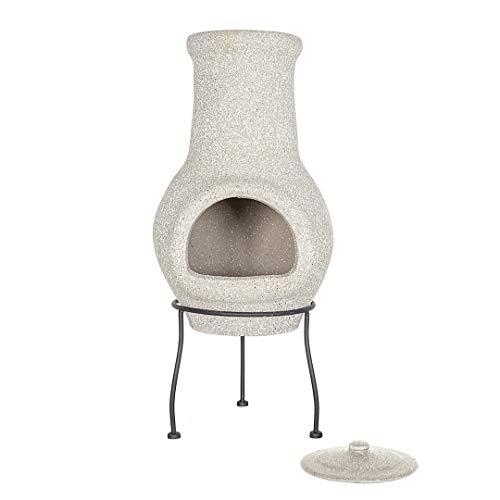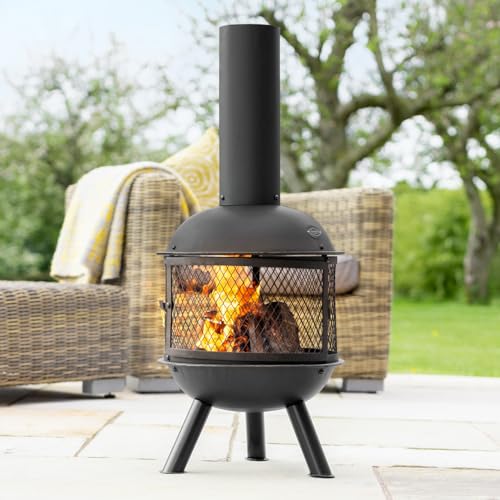The 12 Worst Types Ceramic Chiminea Accounts You Follow On Twitter
페이지 정보

본문
 The Basics of a Ceramic Chiminea
The Basics of a Ceramic ChimineaThe most popular type of chiminea is made out of clay. Think of terra cotta pots or those red pottery ones. Clay is extremely durable and hard, but it is also susceptible to cracking when handled improperly.
Clay is very absorbent, which is why it has to be protected by sand and gravel at the bottom of the chiminea along with some kindling or logs. This stops the clay from burning too hot and prevents hairline cracks from becoming.
Materials
Traditional clay chimineas, sometimes called pot-bellied ovens, come with chimneys that funnel smoke into the air. These types of chimineas have a glaze to protect them against weathering and cracking caused by sudden temperature fluctuations. However, they are still vulnerable to sun and rain. This makes it essential to keep them covered when not in use and to ensure that water puddles do not form inside the clay.
The majority of chimineas are made from terracotta clay. Other materials such as cast iron and steel can be used as well. Cast iron and aluminum are an extremely durable option that requires less maintenance. Terracotta has a classic Mexican look. Some manufacturers offer modern designs which combine the beauty and durability of a clay-based chiminea.
Many people match their chimineas to flowers or evergreen plants. This gives a natural appearance to enhance the ambience in their backyard. It is important to choose the right plant combinations it is essential for a chiminea to be placed in an area that is free of overhead structures that could catch fire. It is crucial to make sure that the chiminea is in a fire pits & chimineas-proof area such as a brick, concrete or stone patio.
A Chiminea And Bbq can be created by hand using high-fired, unglazed clay. The person who forms the clay is referred to as a potter, and they can throw the piece on a potter's wheel or using a mould for plaster. In either case, the clay is kneaded prior to being allowed to dry. Certain newer clay chimineas are pre-grogged with a substance that helps them resist thermal stresses that are prone to cracking traditional earthenware.
Other chimineas can be constructed using metal moulds, which give them various designs and shapes that can be adapted to any backyard. Cast iron chimineas weigh more than clay ones, but they are more durable to the elements and are not as susceptible to cracking or breaking due to sudden temperature fluctuations as clay. They are less expensive than other types of chimineas, too and come with gas-burning models too to provide additional versatility.
Styles
A chiminea is a fireplace that can be decorated in a variety styles and materials. Terracotta chimineas have a classic design that dates back to the past and metal alternatives are more durable and endure high temperatures. Many chimineas feature decorative patterns and designs that match the furniture of the patio. A patina-like finish that is rusty is a good example. It can give a chiminea an old-fashioned style, especially when coupled with iron and wood patio furniture.
Chimineas are often designed to be freestanding, however they may also be mounted on a brick, stone or concrete patio. No matter where you decide to place your chiminea make sure that it is shielded from the elements and from any plants or structures that are flammable. It is crucial to keep in mind that chimineas release smoke and soot that can affect the air quality in the area.
Some chimineas have an opening for the chimney at the base of the structure while others are square and point upwards. Both models come with or without an opening for adding firewood. The chimneys on squat models are also capable of being shaped in order to create an even more striking appearance and also add visual appeal.
You can also add decorative features to the outside of your Chiminea such as marble, wrought iron or granite. Think about a copper or ceramic top to add a touch of elegance. The glossy shimmer of these finishes can help to reflect the light off your fire and enhances the overall appearance of your chiminea.
A regular chiminea polish is a great method to shield your outdoor fire pit from harm and beautify it. Utilize olive oil, beeswax or other natural products to polish the surface to give it an elegant and glowing appearance. Apply a thin coat and gently rub it in after which rinse and dry the largest chiminea to achieve a sparkling result.
Chimineas need a lot of maintenance, but with the right care and attention your creative outdoor chiminea will look stylish for years to come. By implementing effective decorating and maintenance techniques, you can enjoy your backyard chiminea all through the colder months.
Safety
Despite their popularity Chimineas can be dangerous if not handled correctly. Clay chimineas are susceptible to cracking, especially ones that aren't glazed. They can also pose an ignition source when they are placed too close to flammable objects like your furniture outside, your home and the garden. It is best to use a chiminea outdoors and in an area that is fenced or surrounded by fire-proof materials.
Keep a fire extinguisher near you and use it to put out small flames or hot coals which may happen while you tend to your flame. It is also an excellent idea to use a long lighter to light your fire and move coals with tongs rather than with your hands. It is also a great idea to keep an empty bucket of water on hand in case you need to remove the chiminea. However, it is essential to never use water to extinguish a fire that has been chilled down and to only add water after the fire has died down naturally or if a large fire is at risk of bursting into the chimney.
A simple spark arrestor, constructed from chicken wire and positioned in the top of the smokestack can protect your property and your neighbors from burns that could happen. Chimineas also generate a lot of heat and the area surrounding them can get extremely hot, so it is recommended to put up a wall around the chiminea in order to warn people that getting close to it could result in painful burns.
It is not recommended to burn your chiminea during rainy or windy weather, since sparks could set surrounding plants and possibly cause an unintentional chimney fire that could cause damage to your home. Make sure to inquire with your local fire department if there burning restrictions in place prior to using a chiminea large. You should also clean the area around the chiminea before adding firewood, making sure that there aren't any substances that can ignite around. It is also recommended to wash the inside of your chiminea after each use to avoid ash accumulation that could lead to smoke inhalation and a sooty exterior.
Maintenance
Clay chimineas require some maintenance even although they can be used to build outdoor fires. Like all things made from clay, they require being treated with an appropriate amount of care to guarantee their longest possible lifespan. This means avoiding permitting them to get too hot too quickly and making sure to let them cool between each use. They must also be sanded frequently and sealed to keep the paint from being damaged.
The first step to keep your chiminea in good condition is to clear the ashes from it after each use, but only after it has completely cooled down. Although it appears to be cooling down however, the ash will be hot. Use a small brush and rake to get rid of it. After you have carefully removed the ash and disposed of the debris the next step will be to fill the bottom of the chiminea either gravel or sand. If you don't fill it, your chiminea may crack. This is due to the fact that clay absorbs water and can crack if it becomes too dry.
Some sources suggest treating the exterior of a chiminea by using an acrylic waterproofing solution, similar to the ones used to seal tile. This will stop moisture from damaging the chiminea. During periods of heavy use, it is recommended to remove the chiminea and sand it every 6-8 weeks.
Chimineas should only be burned on clean, safe surfaces. They should not be used on decking made of wood or on any other kind of overhead cover. Only using wood that is well-seasoned will reduce the number of sparks and prevent the clay from cracking.
 A chiminea made from clay won't last forever. However, it is not a problem to break unless drop it or beat it with a heavy Hammer. However, cracks can develop due to a variety reasons, such as poor burning and a lack of maintenance. They are also susceptible to rust and need to be covered at the very least, when not in use. This will keep snow and rain from it, so that it does not begin to corrode the metal components of the chiminea.
A chiminea made from clay won't last forever. However, it is not a problem to break unless drop it or beat it with a heavy Hammer. However, cracks can develop due to a variety reasons, such as poor burning and a lack of maintenance. They are also susceptible to rust and need to be covered at the very least, when not in use. This will keep snow and rain from it, so that it does not begin to corrode the metal components of the chiminea.- 이전글15 Strange Hobbies That Will Make You Better At Bean-To-Cup Coffee Machines 24.11.18
- 다음글Need Inspiration? Try Looking Up Text Rewritter 24.11.18
댓글목록
등록된 댓글이 없습니다.
